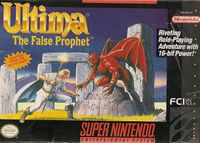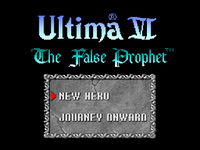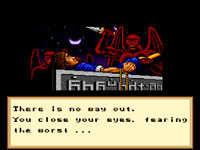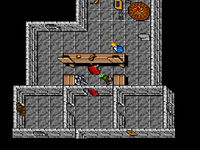SNES-port of Ultima VI
The Super Nintendo-port of Ultima VI came out in 1992, just a couple of years after the original game. The port stayed quite faithful to the original unlike the NES-ports of the earlier games.
Description[edit]
While the graphics for the cutscenes were re-drawn, the in-game graphics are very similar to the PC version (tile graphics of the world and inventory screen), although with a slightly different color palette. The music's quality has been downsampled, but it includes a few more tracks from Ultima V that were not in the original PC version, such as "Britannic Lands". The size of the original game (several megabytes) meant that Origin had to cut several things out of the port to make it fit into the limited memory of the 1 megabyte cartridge.
The original Ultima VI was fully mouse- and keyboard-driven, but the SNES version does not use the SNES mouse at all. The control scheme on SNES had to be significantly changed, making some commands harder to access.
Nintendo Power praised Ultima VI's storyline, depth, and complexity, but felt the view was strange, and the object cursor and combat were awkward. The game received a 3.3/5 for graphics and sound, 2.8 for play controls, 3.4 for challenge, and 3.5 for play and fun.[1]
Included with the Game[edit]
- Instruction booklet (international release)
- Compendium (Japanese release)
Changes[edit]
Listed are the changes to the game, apart from the graphical and audio representation. These had to be done to fit the game onto the cartridge or because of technical limitations:
- No "combat mode"; your party attacks automatically making fleeing from enemies very difficult, and NPCs cannot be attacked.
- Sherry the mouse is an item rather than a party member.
- Several pictures and texts from the introduction were removed.
- There is no character creation – the player only enters a name. There is also no option for a female Avatar.
- The conversations use a tree system, meaning that the player has to learn about a topic before he can ask the character about it.
- There is a useful new "take it?" choice added to look command, but many items can no longer be picked up (like bags).
- There are no character portraits.
- All NPC dialogue had to be streamlined and shortened in order to fit the game into the cartridge. This was used for censorship as well (see below).
- Since the game is fullscreen, thus logically no mouse support, the control scheme is much more complicated with several sub-menus.
- The world is less detailed. Small things like chairs and the ability to sit are gone. There is also less interactivity; for example, looking at paintings is now absent.
- Doors are opened simply by walking into them (unless they need a key).
- The following spells are missing:
- Buildings and the overworld are all separate maps.
- The maximum party size is reduced to six instead of eight.
- Fallen companions will follow as a ghost still carrying all their gear, instead of forcing the player to carry their corpses.
- There is a new auto-attack feature during battles, which lets the Avatar attack based on the same AI logic that his companions use.
Censorship[edit]
Additionally, the game was censored. This was due to Nintendo of America's censorship policies at the time, since they wanted to be a family-friendly company.
- Several text changes in the introduction. Also the picture of the Gargoyle priest with the crossbow bolt in his head was removed.
- The Gargoyles no longer have horns, though they remain horned in the Japanese version.
- Killed enemies do not leave bodies behind – they just vanish.
- There is no blood. There is also no guillotine in Yew.
- Combat text was changed. "X barely/lightly/severely/heavily wounded" becomes "X gets Y points of damage". "X killed" becomes "X is defeated", while defeated party members "expire".
- Resurrection is called Great Awaken.
- It is impossible to attack civilians.
- The spells Kill and Mass Kill were renamed to Destroy and Mass Destroy.
- The spells Mass Death and Armageddon are removed.
- Most of the removed dialogue was critical stuff, for example the perpetrator in Empath Abbey. The remaining dialogues were changed to eliminate words that were on the black list.
- There also is censorship in the manuals and at least two pictures were altered.
- The daemon in the picture in the bestiary lost its horns, hairy crotch and tailtip, and its trident was turned into a normal spear.
- The Gargoyles in the picture in the bestiary lost their horns to make them look less diabolical.
Japanese Version[edit]
This version was released in Japan years before the American release, which was not until 1994. Its original title was Ultima VI: Itsuwari no Yogensha. Other than text language, the two versions appear to be identical. The Japanese version may be less censored.
Gallery[edit]
See Also[edit]
External Links[edit]
- SNES Ultima VI: The False Prophet (YouTube)
- SNES ending of Ultima VI (YouTube)
References[edit]
- ↑ "Now Playing". Nintendo Power (Ultima VI). Jul. 1994. Pages 103, 107.
| Console Ports | |
|---|---|
| Games | Ultima III ☥ Ultima IV ☥ Ultima V ☥ Ultima VI ☥ Savage Empire ☥ Ultima Underworld ☥ Ultima VII |




